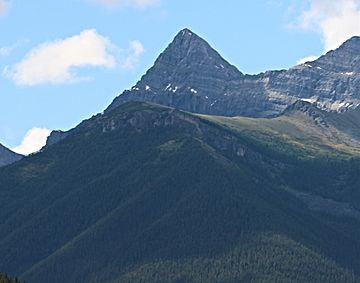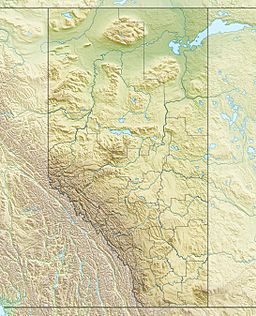Wind Mountain facts for kids
Quick facts for kids Wind Mountain |
|
|---|---|

Wind Mountain seen from Bow Valley
|
|
| Highest point | |
| Elevation | 3,153 m (10,344 ft) |
| Prominence | 745 m (2,444 ft) |
| Parent peak | Mount Galatea (3185 m) |
| Listing | Mountains of Alberta |
| Geography | |
| Location | Alberta, Canada |
| Parent range | Kananaskis Range Canadian Rockies |
| Topo map | NTS 82J/14 |
| Geology | |
| Age of rock | Cambrian |
| Type of rock | limestone |
Wind Mountain is a 3,153-metre (10,344-foot) tall mountain peak. It is found in Kananaskis Country in the Canadian Rockies of Alberta, Canada. Wind Mountain's closest higher peak is Mount Galatea, which is about 13.0 km (8.1 mi) to the south. Both mountains are part of the Kananaskis Range. You can see Wind Mountain from the Trans-Canada Highway in the Bow River valley. It is also visible from Highway 40.
How Wind Mountain Got Its Name
Wind Mountain was first named in 1858 by Eugene Bourgeau. He was part of the Palliser Expedition, a group exploring parts of western Canada. Back then, the mountain was a large area with four peaks. Bourgeau called it "Wind Mountain" because he saw clouds gathering and swirling around its high tops.
Later, in 1928, three of these four peaks were renamed Mount Lougheed. This happened because the family of Sir James Lougheed wanted a mountain named after him after he passed away. Sir James Lougheed was an important Canadian politician.
The peak we now call Wind Mountain was the highest of the original four. It was officially named in 1983 to remember Bourgeau's first naming. The name was formally accepted in 1985 by the Geographical Names Board of Canada.
What is Wind Mountain Made Of?
Wind Mountain is made of a type of rock called sedimentary rock. This rock formed over millions of years, from the Precambrian to the Jurassic periods. It was laid down in shallow seas.
Later, during a time called the Laramide orogeny, these sedimentary rocks were pushed eastward. This powerful movement caused them to slide over younger rocks, forming the mountain we see today.
Weather at Wind Mountain
Wind Mountain has a subarctic climate. This means it has cold, snowy winters and mild summers. In winter, temperatures can drop below −20 °C. With the wind, it can feel even colder, sometimes below −30 °C.
The best time to visit or climb Wind Mountain is from July through September. The weather is usually nicer during these months. Rain and melted snow from the mountain flow into smaller streams. These streams then join the Bow River.



